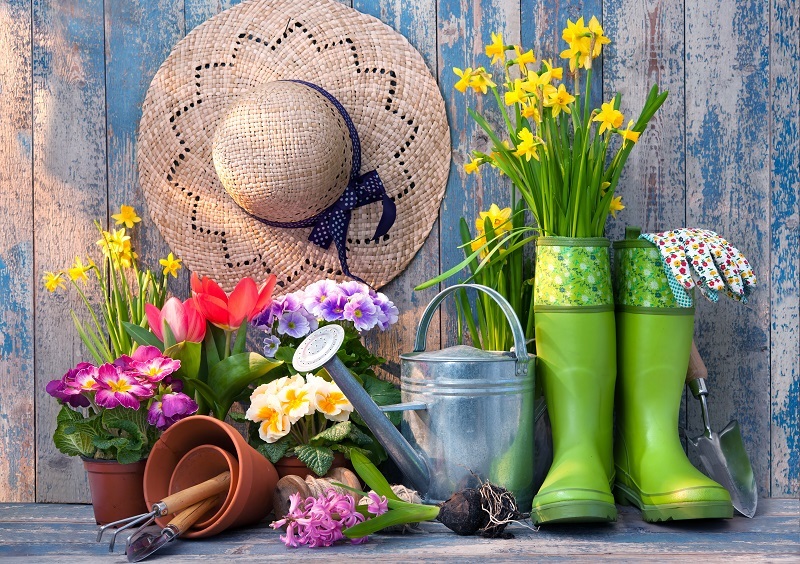Unearth the Significance of Your Birth Flower to Understand Yourself
Posted on 04/09/2025
Unearth the Significance of Your Birth Flower to Understand Yourself
Imagine that nature has been quietly crafting a unique message just for you, blooming each year to mark your arrival into the world. This message is your birth flower. But what does your birth flower mean? And how can learning about it help you understand yourself better? In this comprehensive guide, we'll explore the fascinating tradition of birth flowers, delve into their deep symbolism, and reveal how understanding the meaning of your birth flower can unlock new insights into your personality and inner journey.

The Meaning of Birth Flowers: A Blend of History, Culture, and Sentiment
The tradition of associating flowers with months and personalities dates back centuries, deeply rooted in history and folklore. Birth flowers gained widespread popularity during the Victorian era, when the language of flowers--also known as floriography--emerged as a way for people to express emotions and sentiments they couldn't utter aloud.
Every month boasts a flower (or sometimes two), each carrying its own set of meanings and symbolism. Whether you're a January Carnation or a September Aster, exploring the origin of your birth flower can serve as a window into your innate qualities and identity.
How Can Birth Flowers Reveal Your Personality?
- Symbolism: Each flower is linked to values, emotions, and characteristics.
- Reflection: The meanings can inspire self-reflection and personal growth.
- Tradition: Recognizing your birth flower connects you to old customs and global cultures.
- Personal Growth: Understanding these meanings can enhance your self-awareness and relationships.
Discover Your Birth Flower and Their Powerful Meanings
Ready to unlock the secrets of your birth flower? Below is a month-by-month guide that outlines the symbolism of each birth flower--and perhaps, a bit more about yourself!
January - Carnation & Snowdrop
Carnation: Representing fascination, distinction, and love, carnations are known for their resilience and beauty during winter's chill. If you're born in January, you may naturally exude steadfast loyalty and warmth, even in trying circumstances.
Snowdrop: This delicate bloom stands for hope and rebirth. January babies often offer optimism and light to everyone around them, symbolizing new beginnings.
February - Violet & Primrose
Violet: Known for modesty, loyalty, and faithfulness, violets suggest a deep, quiet strength beneath a gentle exterior. February-born individuals often embody these calm yet fiercely devoted traits.
Primrose: Primroses represent first love, youth, and newness. Those born under this flower are often youthful and fresh, bringing joy to those they meet.
March - Daffodil & Jonquil
Daffodil: Embodying rebirth, renewal, and happiness, daffodils are a breath of spring air. March birthdays are typically marked by optimism, enthusiasm, and a spirited zest for life.
Jonquil: Jonquils speak of desire and affection, hinting at friendly, warm-hearted natures.
April - Daisy & Sweet Pea
Daisy: With meanings tied to innocence, purity, and loyal love, April-born individuals are often straightforward, honest, and cheerful--ready to see the good in everyone and everything.
Sweet Pea: Sweet peas represent delicate pleasure and gratitude. You may be both affectionate and sweet natured, with an appreciation for beauty and art.
May - Lily of the Valley & Hawthorn
Lily of the Valley: This flower stands for humility, sweetness, and the return of happiness. May's children are often seen as gentle souls and bring comfort wherever they go.
Hawthorn: Hawthorn flowers express hope and supreme happiness, suggesting a resilient, optimistic personality.
June - Rose & Honeysuckle
Rose: Roses, with their different colors, symbolize love, passion, and beauty in all forms. June babies often possess a romantic, intuitive, and loyal streak.
Honeysuckle: Honeysuckle denotes everlasting bonds. If your birthday falls in June, you value close relationships and have a magnetic presence.
July - Larkspur & Water Lily
Larkspur: These tall, elegant blooms signify an open heart and renunciation of negativity. July-born people may be strong communicators and naturally inclusive.
Water Lily: Water lilies reflect purity and enlightenment, suggesting a calm, thoughtful nature.
August - Gladiolus & Poppy
Gladiolus: Standing for strength, integrity, and infatuation, gladiolus people are courageous and true to their word.
Poppy: Associated with remembrance and imagination, poppy-born individuals are creative dreamers.
September - Aster & Morning Glory
Aster: Symbolizing faith, wisdom, and valor, individuals born in September are reliable, intelligent, and inspiring.
Morning Glory: Morning glories embody affection and new beginnings, marking a fresh, energetic approach to life.
October - Marigold & Cosmos
Marigold: These vibrant flowers stand for creativity, passion, and warmth. October birthdays might be lively, creative, and driven by intuition.
Cosmos: Cosmos signal peace and order, reflecting a harmonious and balanced soul.
November - Chrysanthemum
Chrysanthemum: This autumn flower signifies joy, loyalty, and longevity. November-born individuals are dependable, supportive, and remain positive even in adversity.
December - Narcissus & Holly
Narcissus: Symbolizing self-respect and rebirth, the narcissus reflects confident, optimistic personalities drawn to new experiences.
Holly: Holly stands for defense and domestic happiness. December babies may be protectors, deeply committed to family and tradition.
How to Embrace and Integrate Your Birth Flower's Meaning into Daily Life
1. Use Your Birth Flower to Practice Self-Reflection
Ask yourself: Do the qualities associated with your birth flower resonate with your personality? Perhaps you recognize certain patterns, or maybe you discover traits you aspire to cultivate. Gently reflect on how these flower characteristics manifest in your life--are you as resilient as the carnation, or as optimistic as the daffodil?
2. Surround Yourself with Your Birth Blossom
- Grow them in your garden or keep a bouquet nearby for daily inspiration.
- Wear jewelry or clothing depicting your birth flower as a personal talisman.
- Use your flower's fragrance--whether real or through essential oils--to lift your spirits.
3. Symbolic Acts and Rituals
Incorporate your birth flower in rituals: Use the symbolism in meditation, journals, or affirmations. For example, if your flower represents hope or new beginnings (like the snowdrop), focus on these concepts during your personal growth practices.
The Cultural Impact of Birth Flowers
From East Asian Lunar celebrations to Western astrology, different cultures assign special symbolism to flowers, influencing art, poetry, and even wedding customs. In Japan, for instance, the hanakotoba system gives each flower a poetic meaning, while in ancient Rome, certain flowers were sacred to gods and celebrated in festivals.
Birth flowers in gifting: Nowadays, floral gifts tailored to someone's birth month are cherished as meaningful symbols, blending beauty with personal attention. These make ideal birthday or anniversary presents, honoring both tradition and individuality.
Why the Meaning of Your Birth Flower Still Matters Today
In an increasingly digital and fast-paced world, connecting with something as simple and beautiful as a flower can be grounding and meaningful. Birth flowers serve as a timeless reminder of our unique strengths, aspirations, and interplay with nature--even as we chart our own course.
Understanding the significance of your birth flower nurtures self-acceptance and curiosity. Whether you're seeking direction during life's crossroads, or simply want a touchstone for everyday mindfulness, your birth flower's story is your own floral anthem--waiting to be unearthed.

Frequently Asked Questions on Birth Flower Symbolism
Are birth flowers linked to astrology?
While birth months and zodiac signs both influence personality, birth flowers offer a botanical parallel rather than an astrological one. However, flower meanings often overlap with zodiac traits, giving a fuller picture of your symbolic makeup.
What if I don't resonate with my birth blossom?
That's perfectly fine! Flower meanings are broad archetypes. You might find other month's flowers more fitting, or may discover their symbolism evolves as you do. The journey is in exploring what each flower represents, regardless of order.
Can I choose a different flower?
Certainly. Your resonance with nature is deeply personal. Many people select favorite blooms for their own symbolism, regardless of traditional birth month assignments.
Are there differences in birth flower traditions worldwide?
Yes! While many Western lists are similar, other cultures may honor different flowers or include unique symbolism. Exploring globally can add layers to your understanding and connection.
In Bloom: Using Birth Flowers as Tools for Self-Discovery
The next time you spot your birth flower, pause and take it in. Consider its history, traditional meanings, and how it naturally grows and thrives. How do these qualities align with your life? Unearthing the significance of your birth flower is about celebrating your story and using nature's wisdom for self-discovery and personal growth. So allow your unique flower to guide you--rooted in tradition, blossoming into new understanding.
- Embrace your flower as a daily reminder of your strengths.
- Share the knowledge of birth flowers with friends and family.
- Let your birth flower guide your self-reflection and growth rituals.
Uncovering the meaning of your birth flower is more than a curiosity--it's an invitation to grow, reflect, and flourish in harmony with the world around you.
Latest Posts
Long-Lasting Blooms: A Top 12 Countdown
Unearth the Significance of Your Birth Flower to Understand Yourself
Guide to Making Your Poinsettias Thrive Longer






